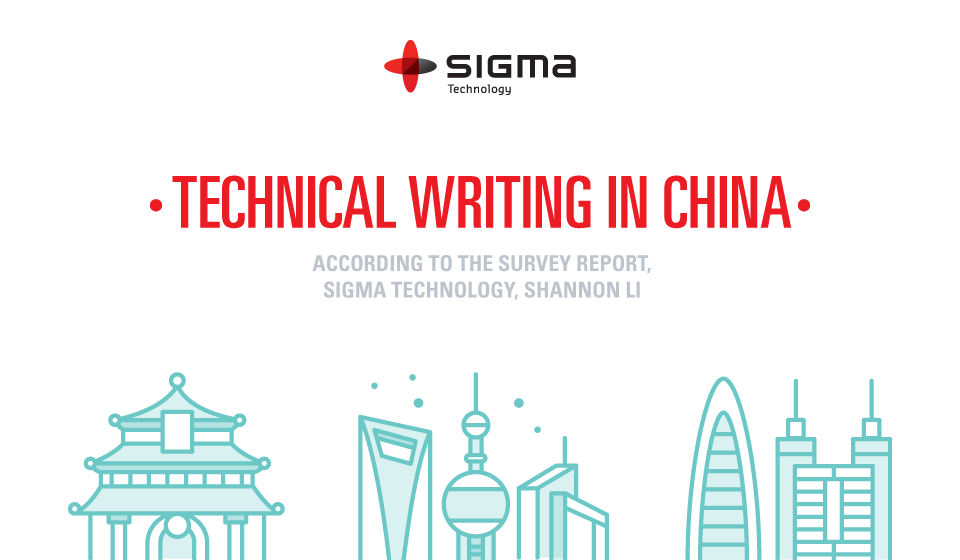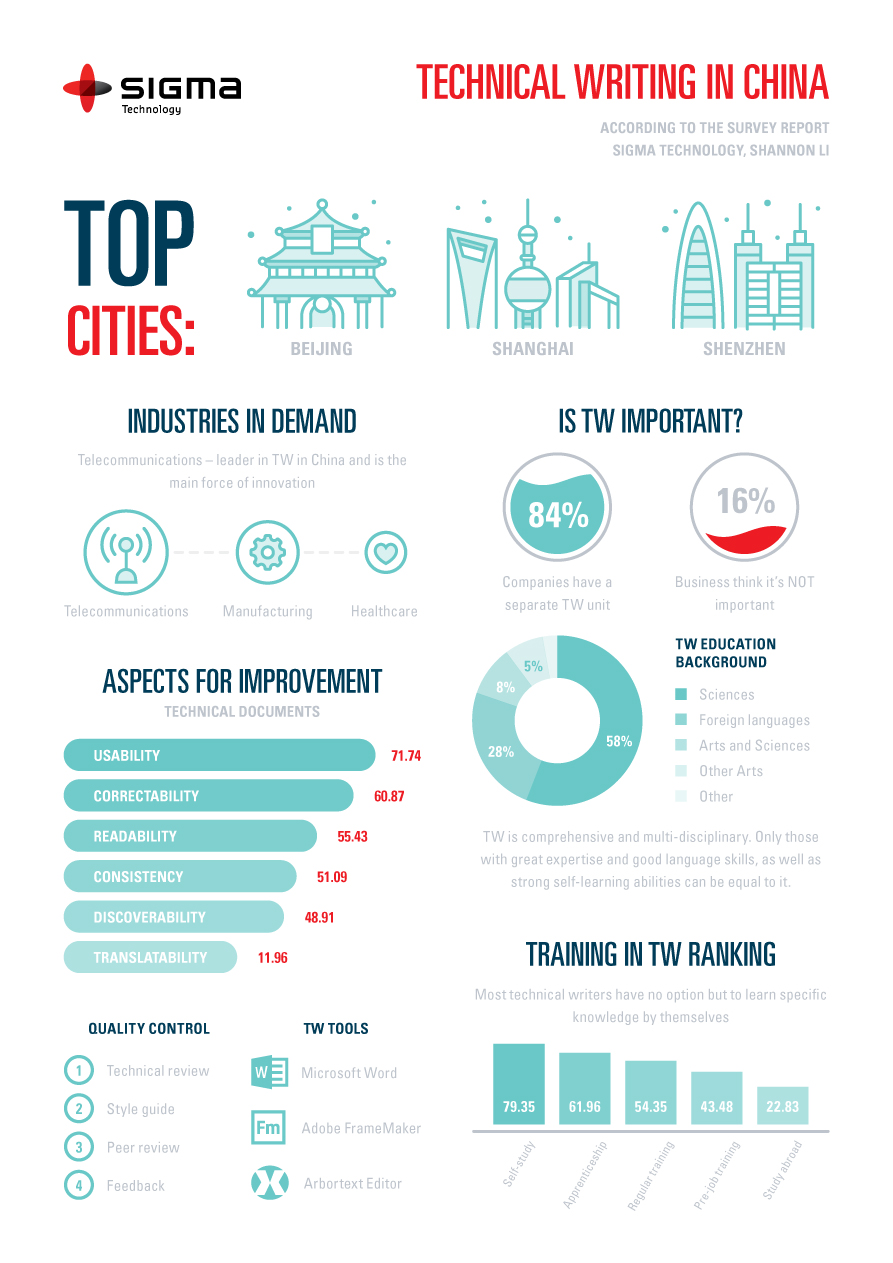
About the survey
Shannon Li and Sigma Technology China (Beijing) made an in-depth investigation to research the current situation of the domestic Product Information development. The survey covers the positive trends in China’s information development and outlines the challenges and solutions.
The area of Product Information (PI) in China has developed a lot during the recent years. The thorough research and field experience helped us to formulate the suggestions for the PI development, including enterprise planning and university talents training.
Respondents of the survey are technical writers and managers of different levels in China. There are 13 questions in the survey, covering 5 aspects about Product Information and technical writing: general information, employees, tools, document authoring & management, and problems & suggestions.
The Infographics
(click the image to zoom)
Product information challenges in China and ways to solve them
As an emerging area, product information faces challenges during its development. Among the problems noted by the responders, neglect of stakeholders, shortage of talents, insufficiency of education, and inadequate policy support are the most critical reasons that slow down the pace of the technical writing development in China.
1. Lack of Awareness about Technical Writing
Product Information has been recognized as an important part of the product development at big enterprises and international companies; however, most leaders and managers in China still don’t realize that technical writing is essential for their businesses.
Such ignorance can ultimately impair the quality of the products and marginalize the technical writer’s profession. Increased publicity and improved education can help solve this problem, helping enterprise executives realize the value of documents.
A fundamental change in opinions calls for a change in the domestic climate. When more products or services go abroad, being tested by international standards, and when the user experience becomes the core of marketing competition, the executives will (or will have to) change their mindset.
2. Development and Innovation
Nowadays, customers have easy access to countless information resources and consumption environments. They can get information from various media such as paper, e-book, webpage, audio-video, etc., from channels such as television, website, radio, and new communication platforms like WeChat. Therefore, documentation should keep up with new technologies to serve readers better, gradually enhancing its value and influence.
Product Information development requires new technologies and formats for technical writing as new carrier of content to attract readers.
3. Standards and Guidelines
Nothing can be accomplished without norms or standards. It’s true for technical writing too. A set of feasible writing guidelines can assure standardization of documents, thus saving cost in review and communication.
There are many great style guides like The Chicago Manual of Style, which has become a must-have reference for many industries and enterprises. While in China, it is still a direction for the future to develop authoring style guides in English or in Chinese. A few big enterprises have worked out their own internal style guides; however, they only circulate internally.
It’s suggested that leading enterprises and professionals would form an alliance to set up authoring standards for the industry and then enhance the soft power of products.
4. Education and Training
The education challenge for Product Information lies in equipping technical writers with the right knowledge and skill set.
Few universities and enterprises provide professional education and training in technical writing. The communication opportunities and platforms are so limited that even technical writers and R&D personnel in the same enterprise often risk having miscommunication.
Most technical writers used to do a different occupation, and therefore they haven’t received any professional education or training at all. To address this deficiency, universities should establish technical writing courses to train talents, and leading enterprises should cooperate to provide more training opportunities and platforms to equip technical writers with domain knowledge and professional skills.
Sigma Technology China is among enterprises that aim to improve the learning environment and drive technical communication communities. Apart from conducting regular training sessions on both technical writing and language itself, Sigma Technology China’s MD Nate Zhang holds a course in Peking University.
5. Technology and Humanity
Humanity is seriously absent from domestic education, especially in technical education. As a result, it alienates people from machines. The same is true for technical writing, where humanity is gravely neglected. As a matter of fact, documentation is more than an introduction of products or informing customers of “what the product is”, but a means to help them easily find out “what the product can do for you”. So the documentation should turn from self-centered mode of preaching into user-centered service mode that takes users’ affection appeals into account.
When a document can pin down the doubtful, difficult or even painful points for customers, the exquisite design, novel form and fluent expression shall strike a responsive chord in the hearts of users. This is the charm of top-level documents.
Conclusion
Things in their fledging stages of development are inevitably vulnerable to different obstacles. So is technical writing. However, it takes an upward spiral throughout the whole process of development. We should have confidence in technical writing as a profession. Technical documents in the future should have more humanity to become human-centered, friendly, and empathetic.
For this purpose, an ecosystem should be established within and among enterprises. Internally we need to look at the information transmission process from the point of technical communication, where personnel such as subject matter experts, project managers, technical writers, technical illustrators, testers, technical editors, user experience designers, etc., should cooperate with one another.
Externally, enterprises should form an alliance or cooperate with other organizations to set up authoring standards, strict access mechanism and take this industry to a higher level. What’s more, support from other bodies, such as government and universities, is vital as well.
Lastly, here is a question for us to mull over: most present practice and discussion of product information mainly focus on English. What should we do about Chinese then, and many other minority languages?
It’s time for us to do something and only we ourselves can do it well.
The full version of the report in Chinese can be viewed on Sigma Technology’s Weibo Profile.
To request more information and get the English version of the survey, please contact us at china@sigmatechnology.com.
